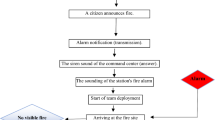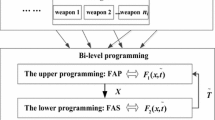Abstract
In this paper, a mathematical formulation is presented for fire station’s locating and facilities allocating to stations in different periods and emergency situations (wars and natural disasters). This model is designed, considering amount of demands and facilities coverage radius, being dynamic based on traffic and type region and fuzzy in different periods. According to fact, in the model, amount of demand for each demand point depends on number of coverage and the location. In this model, location of stations is positioned once in different periods. The number of facilities which are allocated to stations are located dynamically and can be relocated in different periods. Since the proposed model is NP-hard, particle swarm optimization (PSO) and artificial bee colony (ABC) algorithms by considering an efficient combinatorial chromosome are presented to solve the problem at hand. In the PSO, way of making chromosome is such that locating chromosome, early and final allocation are presented in a novel approach. The results demonstrated that the presented PSO are better than ABC in terms of quality of solutions and computational time.










Similar content being viewed by others
References
Afzal S, Padmanabh T (2017) Reduced order modelling of linear time invariant system using modified cuckoo search algorithm. Soft Comput 22:3449–3459
Afzal S, Rajendra P (2017) New technique for system simplification using cuckoo search and ESA. Sadhana 42:1453–1458
Araz C, Selim H, Ozkarahan I (2007) A fuzzy multi-objective covering-based vehicle location model for emergency services. Comput Oper Res 34:705–726
Aytug H, Saydam C (2002) Solving large-scale maximum expected covering location problems by genetic algorithms: a comparative study. Eur J Oper Res 141:480–494
Barbas J, Marin Á (2004) Maximal covering code multiplexing access telecommunication networks. Eur J Oper Res 159:219–238
Basar A, Çaray B, Ünuyurtt T (2011) A multi-period double coverage approach for locating the emergency medical service stations in Istanbul. J Oper Res Soc 62:627–637
Batanovic V, Petrovic D, Petrovic R (2009) Fuzzy logic based algorithms for maximum covering location problems. Inf Sci 179:120–129
Berman O, Huang R (2008) The minimum weighted covering location problem with distance constraints. Comput Oper Res 35:356–372
Berman O, Krass D (2002) The generalized maximal covering location problem. Comput Oper Res 29:563–581
Berman O, Wang J (2011) The minmax regret gradual covering location problem on a network with incomplete information of demand weights. Eur J Oper Res 208:233–238
Berman O, Krass D, Menezes MBC (2007) Facility reliability issues in network p-median problems: strategic centralization and co-location effects. Oper Res 55:332–350
Berman O, Drezner Z, Wesolowky GO (2009) The maximal covering problem with some negative weights. Geogr Anal 41:30–42
Bhatt R, Parmar G, Gupta R, Sikander A (2018) Application of stochastic fractal search in approximation and control of LTI systems, Microsystem Technologies pp 1–10.
Canbolat MS, Vonmassow M (2009) Planar maximal covering with ellipses. Comput Ind Eng 57:201–208
Colombo F, Cordone R, Lulli G (2016) The multimode covering location problem. Comput Oper Res 67:25–33
Curtin KM, Hayslett-Mccall K, Qie F (2010) Determining optimal police patrol areas with maximal covering and backup covering location models. Netw Spat Econ 10:125–145
De Assis CF, Lorena LAN, Ribeiro GM (2009) A decomposition approach for the probabilistic maximal covering location-allocation problem. Comput Oper Res 36:2729–2739
Eberhart R, Kennedy J (1995) A New Optimizer Using Particle Swarm Theory, In: Proceedings of the sixth international symposium on machine and human science, pp 39–43.
Erdemir ET, Battar SS, Rogerson PA, Blatt A, Flanigan M (2008) Location coverage models with demand originating from nodes and paths: application to cellular network design. Eur J Oper Res 190:610–632
Espejo LGA, Galvao RD, Boffey B (2003) Dual-based heuristics for a hierarchical covering location problem. Comput Oper Res 30:165–180
Fajardo Calderín J, Nodarse CP, Year LS, Diago E, Rodrígue E (2017) Software tool for model and solve the maximum coverage location problem a case study: location police officers. Revista Invest Oper 2:141–149
Farahanir Z, Hassani A, Mousavis M, Bayagi MB (2014) A hybrid artificial bee colony for disruption in a hierarchical maximal covering location problem. Comput Ind Eng 75:129–141
Galvao RD, Espejo LGA, Boffey B (2000a) A comparison of Lagrangean and surrogate relaxations for the maximal covering location problem. Eur J Oper Res 124:377–389
Galvao RD, Gonzalo AcostaC Espejo L, Boffey B (2000b) A comparison of Lagrangean and surrogate relaxations for the maximal covering location problem. Eur J Oper Res 124:377–389
Galvao RD, Espejo LGA, Boffeyb B (2002) A hierarchical model for the location of perinatal facilities in the municipality of Rio de Janeiro. Eur J Oper Res 138:495–517
Gendreau M, Laporte G, Semet F (2001) A dynamic model and parallel tabu search heuristic for real-time ambulance relocation. Parallel Comput 27:1641–1653
Gumawarane G (1982) Dynamic versions of set covering type public facility location problems. Eur J Oper Res 10:190–195
Hajipour V, Zanjiranifarahani R, Fattahi P (2016) Bi-objective vibration damping optimization for congested location-pricing problem. Comput Oper Res 70:87–100
Hasanzadeh H, Bashiri M, Amiri A (2018) A new approach to optimize a hub covering location problem with a queue estimation component using genetic programming. A Soft Comput 22:949. https://doi.org/10.1007/s00500-016-2398-1
Ibrahim MK, Ali RS (2016) Novel optimization algorithm inspired by camel traveling behavior. Iraq J Electric Electron Eng 12:167–178
Jeetendra A, Girish P Rajeev G, Afzal S (2018) Analysis of grey wolf optimizer based fractional order PID controller in speed control of DC motor. Microsystem Technologies pp 1–10
Karaboga D (2005) An idea based on honey bee swarm for numerical optimization, Technical Report-TR06, Erciyes University, Engineering Faculty, Computer Engineering Department
Karasakal O, Karasakale K (2004) A maximal covering location model in the presence of partial coverage. Comput Oper Res 31:1515–1526
Kumar Sharma T, Millie P (2018) Identification of noise in multi noise plant using enhanced version of shuffled frog leaping algorithm. Int J Syst Assur Eng Manage 9:43–51
Lee JM, Lee YH (2010) Tabu based heuristics for the generalized hierarchical covering location problem. Comput Ind Eng 58:638–645
Li Q, Zeng B, Savachkin A (2013) Reliable facility location design under disruptions. Comput Oper Res 40:901–909
Marianov V, Revelle C (1994) The queuing probabilistic location set covering problem and some extensions. Socioecon Plann Sci 28:167–178
Marianov V, Serra D (2001) Hierarchical location–allocation models for congested systems. Eur J Oper Res 135:195–208
Masegosa AD, de la Iglesia I, Hernandez-Jayo U, Diez LE, Bahillo A, Onieva E (2018) A New Approach for Information Dissemination in VANETs Based on Covering Location and Metaheuristics. In: Cruz Corona C (eds) Soft computing for sustainability science. studies in fuzziness and soft computing, vol 358. Springer, Cham
Moore GC, Revelle C (1982) The hierarchical service location problem. Manage Sci 28:775–780
Murawski L, Church RL (2009) Improving accessibility to rural health services: The maximal covering network improvement problem. Socioecon Plann Sci 43:102–110
O’hanleyChurch JRRL (2011) Designing robust coverage networks to hedge against worst-case facility losses. Eur J Oper Res 209:23–36
Peidro D, Mula J, Poler R, Verdegay JL (2009) Fuzzy optimization for supply chain planning under supply, demand and process uncertainties. Fuzzy Sets Syst 160:2640–2657
Qu B, Weng K (2009) Path relinking approach for multiple allocation hub maximal covering problem. Comput Math Appl 57:1890–1894
Rajagopalan HK, Saydam C, Xiao J (2008) A multiperiod set covering location model for dynamic redeployment of ambulances. Comput Oper Res 35:814–826
Ratick SJ, Osleeb JP, Hozumi D (2009) Application and extension of the Moore and ReVelle hierarchical maximal covering model. Socioecon Plann Sci 43:92–101
Repede JF, Bernado JJ (1994) Developing and validating a decision support system for locating emergency medical vehicles in Louisville, Kentucky. Eur J Oper Res 75:567–581
Revelle CS, Eiselt HA (2005) Location analysis: a synthesis and survey. Eur J Oper Res 165:1–19
Revelle C, Scholssberg M, Williams J (2008a) Solving the maximal covering location problem with heuristic concentration. Comput Oper Res 35:427–435
Revelle CS, Eiselt HA, Daaskin MS (2008b) A bibliography for some fundamental problem categories in discrete location science. Eur J Oper Res 184:817–848
Şahin G, Sural H (2007) A review of hierarchical facility location models. Comput Oper Res 34:2310–2331
Sait A, Uymaz GT, E, (2013) Artificial algae algorithm(AAA) for nonlinear global optimization. Appl Soft Comput 31:153–157
Schillingd A (1980) Dynamic location modeling for public-sector facilities: a multicriteria approach. Decis Sci 11:714–724
Shandi H, Mahloohi H (2006) A fuzzy queuing location model with a genetic algorithm for congested systems. Appl Math Comput 181:440–456
Shandi H, Mahloohi H (2007) Fuzzy hierarchical location-allocation models for congested systems. J Indus Syst Eng 1:171–189
Shen ZJM, Zhan RL, Zhang J (2011) The reliable facility location problem: formulations, heuristics, and approximation algorithms. INFORMS J Comput 23:470–482
Shi Y (2015) An optimization algorithm based on brainstorming process. Emerging Research on Swarm Intelligence and Algorithm Optimization, pp 1–35.
Snyder LV, Daskin MS (2005) Reliability models for facility location: the expected failure cost case. Transp Sci 39:400–416
Xia L, Xie M, Xu W, Shao J, Yin W, Dong J (2009) An empirical comparison of five efficient heuristics for maximal covering location problems. Service Operations, Logistics and Informatics. SOLI'09 IEEE/INFORMS International Conference on IEEE 747–753
Younies H, Wesolowsky GO (2004) A mixed integer formulation for maximal covering by inclined parallelograms. Eur J Oper Res 159:83–94
Author information
Authors and Affiliations
Corresponding author
Additional information
Publisher's Note
Springer Nature remains neutral with regard to jurisdictional claims in published maps and institutional affiliations.
Rights and permissions
About this article
Cite this article
Hajipour, V., Fattahi, P., Bagheri, H. et al. Dynamic maximal covering location problem for fire stations under uncertainty: soft-computing approaches. Int J Syst Assur Eng Manag 13, 90–112 (2022). https://doi.org/10.1007/s13198-021-01109-8
Received:
Revised:
Accepted:
Published:
Issue Date:
DOI: https://doi.org/10.1007/s13198-021-01109-8




